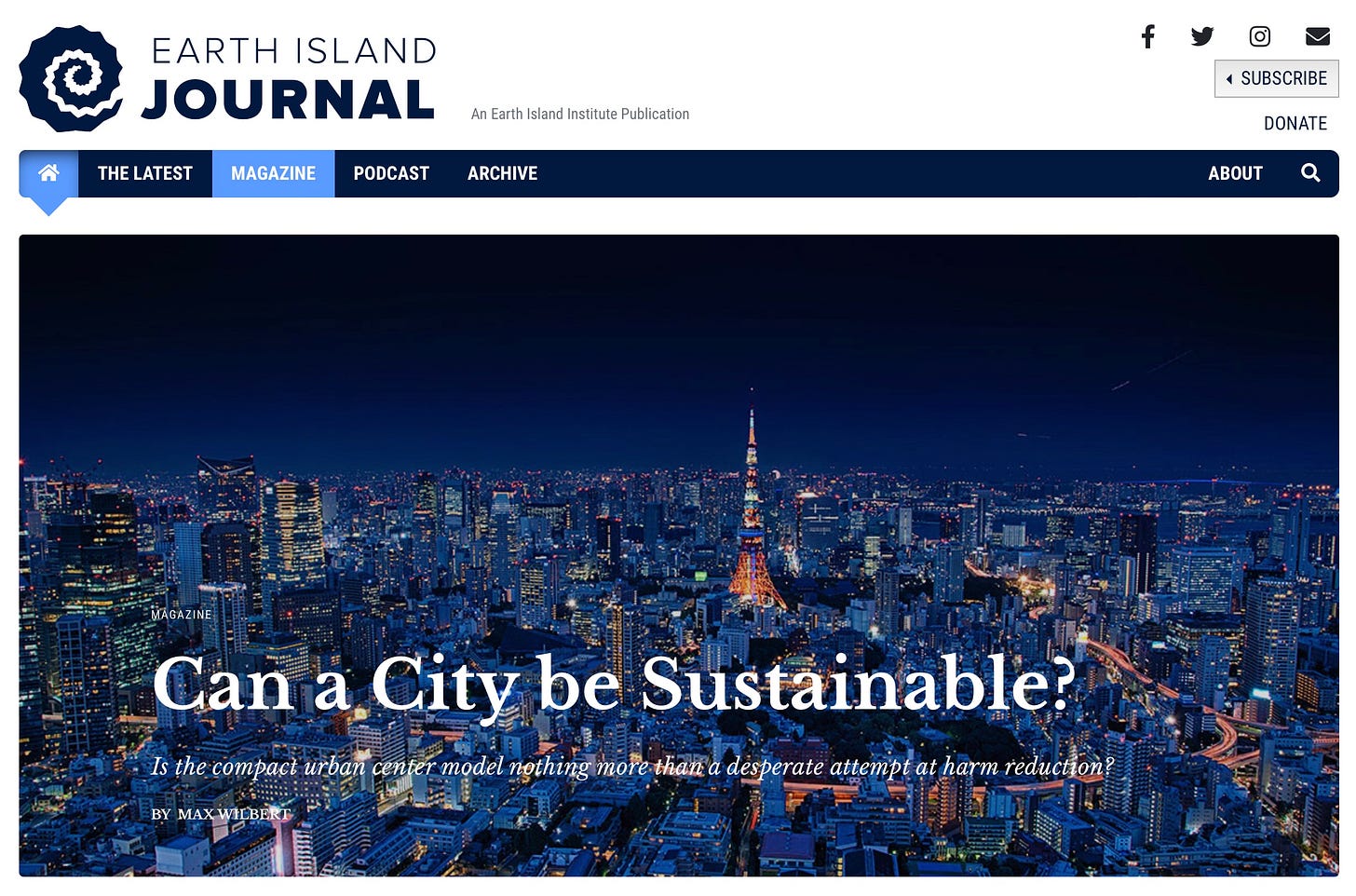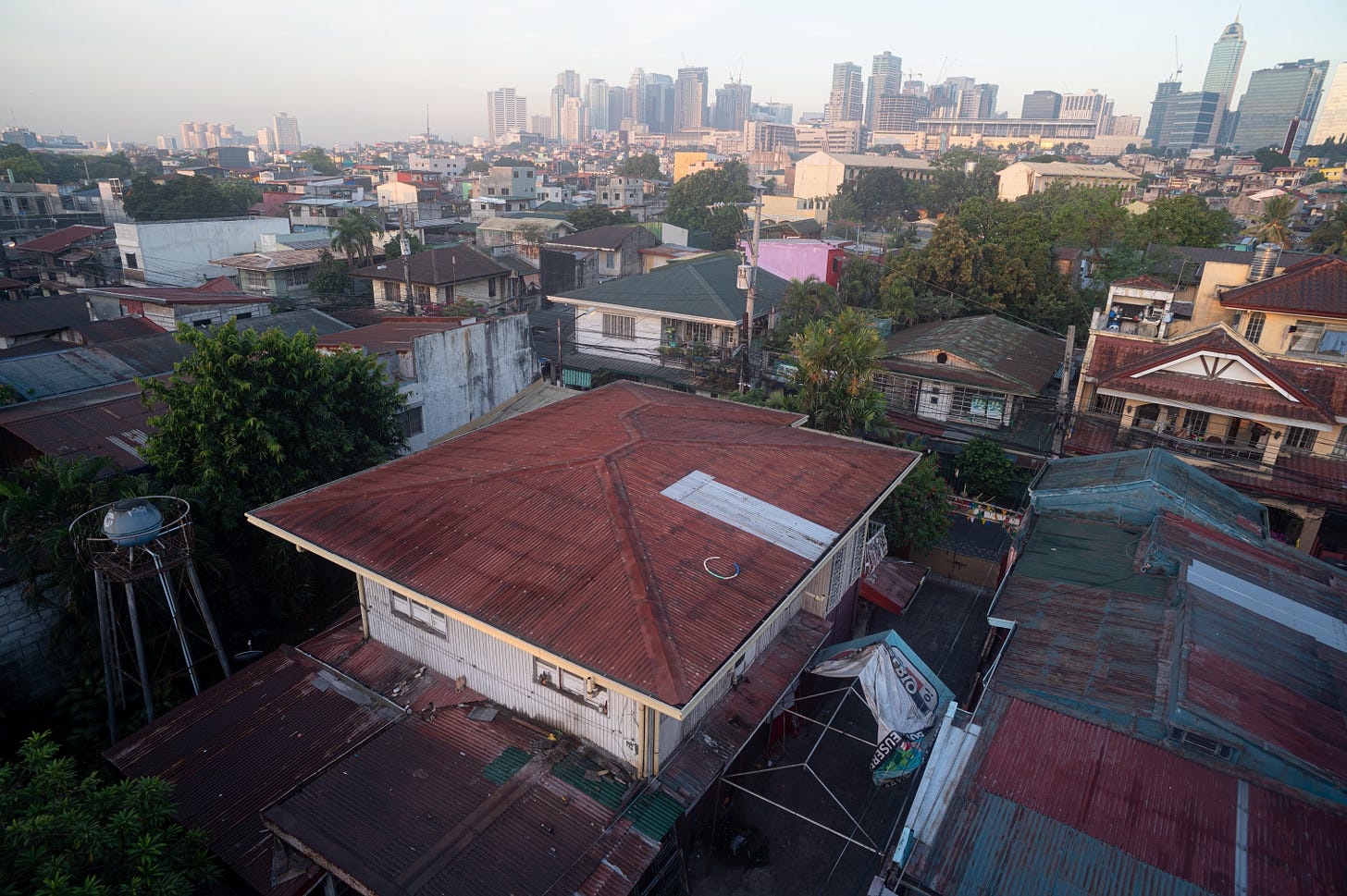Can A City Be Sustainable?
Is the compact urban center model nothing more than a desperate attempt at harm reduction?
This article was originally published in Earth Island Journal’s Autumn 2022 issue.
It’s 6 A.M and the sun is rising over the still waters of Manila Bay. Just offshore, a fisherman squats on a small wooden boat, pulling nets from the water. Ripples spread from a concrete pipe regurgitating untreated sewage. A scraggly line of trees separates the bay from an eight-lane superhighway clogged with traffic. I’m in a coach bus on that highway, heading to a primary school to give a presentation on sustainability. The bus has 49 seats, and I count 77 people on board.
My first day out in Manila is like a punch in the face. Sweaty people crowd the streets. Trucks, cars, and “jeepneys” — converted US Army jeeps from World War II that look like a cross between a stretch limo and something from the dystopian film Mad Max — rumble across potholed pavement, motorcycles and pedestrians weaving in between swirls of exhaust from oft-repaired diesels and two-stroke engines. I inhale, breathing in tropical air heavy with humidity, heat, and smog. I exhale, breathing out cleaner air, leaving behind pollutants lodged in my lungs.
In case you’re new here, this is Biocentric, a newsletter about sustainability, overshoot, greenwashing, and resistance. It’s written (mostly) by me, Max Wilbert, the co-author of Bright Green Lies: How the Environmental Movement Lost Its Way and What We Can Do About It and co-founder of Protect Thacker Pass. If you want to follow, you can subscribe for free. In return for supporting my activism, paid subscribers receive access to occasional private posts containing behind-the-scenes reports and unreleased drafts.
Manila, the capital region of the Philippines, is officially made up of 16 separate municipalities, but over the years they have merged into one megalopolis of 21.3 million inhabitants. As far as megacities go, Manila is relatively small — 18th in the world, less than half the size of Tokyo. But it is the densest metropolitan area on the planet: 55,000 people per square mile, 85 per acre. At my home in rural Oregon, I live with five other people on eight acres. In Manila, those eight acres would be home to at least 680 people.
Two hundred years ago, less than 10 percent of human beings — fewer than 100 million — lived in cities. Today, the three most populous urban areas — the Pearl River Delta megacity, Tokyo, and Delhi — have a combined population of more than 110 million, and somewhere between 55 and 84 percent of all human beings (4.4 to 6.7 billion people) live in cities.
According to most environmentalists, our increasing urbanity is a good thing. As people move into cities, they argue, we can use public transportation rather than private cars, reducing pollution and greenhouse gas emissions. Housing is more efficient, too, since high-density apartments mean a lower per-capita use of materials and energy. And with walkable neighborhoods, people can live close to their work, grocery stores, restaurants, medical clinics, and so on, further cutting their energy needs.
This idea is extremely popular. United Nations official Maimunah Mohd Sharif said in 2019 that “compact, walkable cities with good public transport greatly reduce our per capita carbon footprint.” The Organization for Economic Cooperation and Development (OECD) says that “compact cities lessen the impact on the environment with … less automobile dependency.” Elizabeth Farrelly, in her popular book Blubberland, is even more explicit: “If we were to design a green settlement-pattern from scratch,” she writes, “it would not be suburbia, or urban villages, or Greek fishing towns, or even say, Barcelona. It would be Manhattan. Manhattan — or something like it — is the greenest city on earth.”
I’ve been to Manhattan, and with all due respect to Elizabeth Farrelly, it looks grey, not green, and so does Manila. My instincts were telling me that these city proponents were wrong, so I started reading all the academic literature I could find, and immediately the narrative of the sustainable city broke down.
DR. MICHAEL NEUMAN, an urban planning professor with the University of Westminster, London, wrote in 2005 that studies “are not conclusive about the link between higher densities and reduced automobile trips,” and that “the relation between compactness and sustainability can be negatively correlated, weakly related, or correlated in limited ways.”
Another expert, Dr. Paul James, a professor of globalization and cultural diversity at Western Sydney University and former director of the UN Global Compact Cities Programme, wrote that “even the world’s most ‘liveable cities’ — Melbourne, Munich, Vancouver, and Vienna — are utterly unsustainable in global ecological terms.” He continues: “If all city residents across the globe consumed at the rate of the world’s most livable cities the planet would be in catastrophic trouble. Despite their inconsequential geographical footprint, cities are responsible for around 80 percent of global energy consumption, and some of the world’s most wonderful exciting cities contribute at a proportionally much higher rate.”
Over the past 40 years, the amount of urbanized space globally has increased by 250 percent. In the United States, the data is staggering: Between 1945 and 2000, more than 45 million acres — an area the size of Washington State — was converted from farms, forests, and fields to urbanized land, and more species have become endangered from this process than from any other activity. And the land directly impacted by cities is not even the whole story. Cities require vast swathes of what Georg Borgstrom called “ghost acreage”— land that is not considered to be part of a city, but is essential to feed, clothe, and house the populace.
These generalizations are backed up by the histories of specific cities. Historical Geographer Gray Brechin’s little-known 1999 masterpiece Imperial San Francisco: Urban Power, Earthly Ruin, for example, paints a picture of San Francisco’s urban growth driven by what he calls “a pyramid whose base consists of mechanization, metallurgy, militarism, and moneymaking (or finance) and whose apex is mining.” He continues: “From the union of all five … the pyramid derives its accelerating power to transform both human society and the organic world, to its own growing peril and to that of all.” From the damming of Hetch-Hetchy to the mining of the Sierra Nevada foothills to the collapsing biodiversity of the San Francisco Bay itself, the land has paid the price for the growth of the city.
This isn’t a new problem, either. One study of the site of a 6,000-year-old city on Palestinian land now claimed by Israel found that the urban growth of both modern and ancient cities “involves one of the most extreme forms of ecological stress and land alteration,” noting that “concentration of agricultural, industrial, and commercial activities” in the Akko area led to “a loss of natural biotopes” and a “lack of resilience of coastal ecosystems” characterized by forests that have not grown back despite the city being mostly abandoned for 650 years. “The same mechanisms that degrade or overexploit the ecosystems nowadays were already at work [6,000 years ago],” the authors of the study write. “Accepting large urban concentrations might [mean] an intrinsic impossibility to produce locally sustainable development.”
Neuman summarized the issue: “Since 1960, while human population has doubled, the global economy has quadrupled, and resource consumption quintupled. Thus, we are getting less efficient and less sustainable as we move to cities, not more, contrary to popular belief and professional dogma.” He concludes, rather starkly, that “there is no such thing as a sustainable city.”
IF THE EVIDENCE IS SO CLEARLY stacked against the compact city model, why has it gained so much traction?
To cite Neuman again, he concludes that environmentalists, planners, and politicians rely on the compact city model since they “do not know what [else] to do to be sustainable.”
Back in the Philippines, in my friend’s small apartment, our discussion is not about factory farms, illegal logging, nickel mines, or the super-powered typhoons that seem to hammer the Philippine archipelago each year. It is about the city itself. Solving environmental problems, we decide, is the ultimate chicken-and-egg paradox. Is the city a cause or a symptom? Or both? Growing cities, burgeoning populations, spiraling pollution issues, rising consumption — they all go hand-in-hand.
Talk of population growth is taboo in the Philippines, where 83 percent of people are Catholic. But the numbers are unavoidable. From a population of less than 20 million in 1950, the country has ballooned to nearly 120 million today. In the United States, the rate of growth may be slower, but the numbers are bigger: From 160 million in 1950, our population doubled to 320 million by 2015. And of course, “to separate consumption from population,” as well-known biologist Paul Ehrlich said in one interview, “is like saying the length of a rectangle contributes more to its area than its width.” With 5 percent of the world population, the United States consumes 24 percent of the world’s energy, and correspondingly uneven amounts of other resources.
In this context, the compact city model seems to be a desperate attempt at harm reduction, like a homeowner piling sandbags in the faint hope of stopping rising floodwaters. But our problem spans the whole globe: As the rising floodwaters are kept from surging into one area, they get correspondingly deeper elsewhere.
This is the part of the story where I am supposed to provide a solution. But I won’t lie by painting a cheery picture of benevolent corporations and astute politicians guiding us to a better world. Our environmental impact is spiraling, and despite all of our best efforts, everything — consumption, carbon emissions, toxification, biodiversity, and so much more — is heading in the wrong direction. James describes cities as being “the center of this human-made maelstrom.” And as environmental awareness has grown, so has greenwashing. We are being offered false solutions by people who “do not know what to do to be sustainable,” he writes.
The confusion is understandable. It seems that dense, compact cities are no solution, but spreading 8 billion people into rural communities is no more reasonable. We’re in a predicament, and there does not appear to be a silver bullet, deus ex machina, or techno-fix that will magically lift us into sustainability.
But still, in spite of the evidence, I am something of an optimist. And I believe we might yet find our way towards a more sustainable future. Not through some sort of magical transformation, but through a long, harrowing path of community organizing, education, and political confrontation.
Our urbanity is relatively new, and what is new can change or be abandoned. Thankfully, change is what humans are best at. We are profoundly adaptable. It is not inconceivable that, by endless hard work and a fair share of miracles, we can reject the world of cities and unsustainability, arrest and reverse population growth, dramatically reduce our consumption, and halt the destruction of the planet. The things that are killing the planet were built by humans, and we can dismantle them, too. The natural world has an incredible capacity to heal, and while some places — like Akko — will bear their scars for millennia, others will heal more quickly. If we stop destroying.
The sun is setting over Manila. With my friends, I look out over the city. Modern skyscrapers and malls rise on one side, cardboard and corrugated metal slums on the other. A storm is blowing in, cleaning out the smog and bringing cool air from the disputed waters of the South China Sea. Birds are singing, and I breathe in the momentarily fresh air.
--
Photos from my time in the archipelago (decolonized name for the Philippines):













